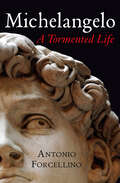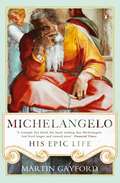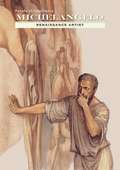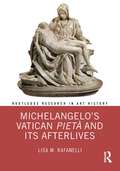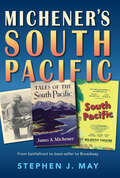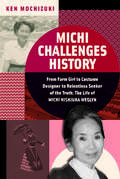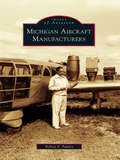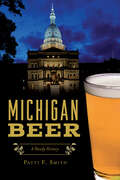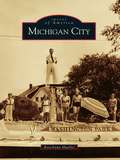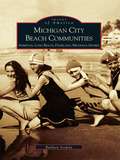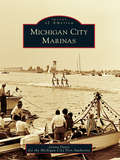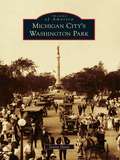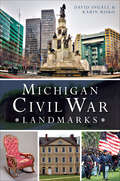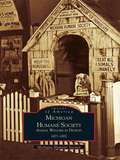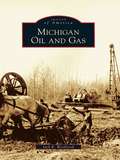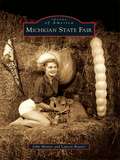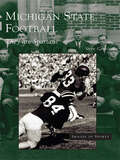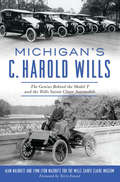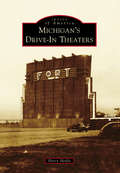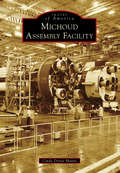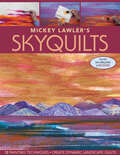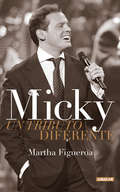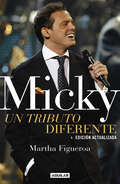- Table View
- List View
Michelangelo: A Study In The Nature Of Art (Routledge Classics)
by Adrian StokesAdrian Stokes was one of the twentieth century's finest and most discriminating writers on art. Of over twenty works of art criticism, Michelangelo was considered by Lawrence Gowing to be the most complete he ever wrote, presenting an understanding of the great artist that no one subsequently could afford to ignore. Stokes brings to bear in this work not only twenty-five years' study and appreciation of Italian Renaissance art and of aesthetics, but also a unique psychological perspective, as he explains in his introduction, which enables him to uncover the depths of the artist's personality. The subtlety of feeling and profound knowledge of sculpture which Sir Herbert Read admired in Stokes's work is also combined with a literary style perfected through his own poetry and criticism. Presenting a unique survey of his subject's literary as well as his artistic legacy, Stokes succeeds, as no other has before or since, in his aim of bringing Michelangelo's greatness into nearer view.
Michelangelo: A Tormented Life
by Antonio ForcellinoThis major new biography recounts the extraordinary life of one of the most creative figures in Western culture, weaving together the multiple threads of Michelangelo’s life and times with a brilliant analysis of his greatest works. The author retraces Michelangelo’s journey from Rome to Florence, explores his changing religious views and examines the politics of patronage in Renaissance Italy, politics that were complicated by the fact that Michelangelo worked for both the Medici and the Papacy. He discusses Michelangelo’s character in detail, showing him to be a tormented man, solitary, avaricious, deeply religious, burdened with repressed homosexuality and a surplus of creative enthusiasm. Drawing on Michelangelo’s memoirs and personal correspondence, the author paints a portrait of a deeply contradictory man whose work was infused with a sensuality of which he chose to deprive himself. For the first time, Forcellino explores the spiritual turning point Michelangelo experienced between the late 1530s and the early 1540s, a crucial period when he created some of his most important works, such as the Universal Judgement and Moses. Forcellino offers a systematic reconstruction and interpretation of the frescos in the Paolina Chapel which Michelangelo completed in the late 1540s. Although less well-known than their counterparts in the Sistine Chapel, Forcellino shows that these frescos are among the artist’s supreme achievements. The author also seeks to reconstruct the last years of Michelangelo’s life, dark years of which we know very little but which are fundamental to the posthumous creation of the Michelangelo legend. As a restorer and a recognized expert on Michelangelo, Forcellino took part in the restoration of the Sistine Chapel and Moses, two projects which gave us a new perspective on the techniques used by Michelangelo, the way he worked with colour and marble and the tools he used.
Michelangelo: His Epic Life
by Martin GayfordAt thirty one, Michelangelo was considered the finest artist in Italy, perhaps the world; long before he died at almost 90 he was widely believed to be the greatest sculptor or painter who had ever lived (and, by his enemies, to be an arrogant, uncouth, swindling miser).For decade after decade, he worked near the dynamic centre of events: the vortex at which European history was changing from Renaissance to Counter Reformation. Few of his works - including the huge frescoes of the Sistine Chapel Ceiling, the marble giant David and the Last Judgment - were small or easy to accomplish. Like a hero of classical mythology - such as Hercules, whose statue he carved in his youth - he was subject to constant trials and labours.In Michelangelo Martin Gayford describes what it felt like to be Michelangelo Buonarroti, and how he transformed forever our notion of what an artist could be.
Michelangelo: Renaissance Artist
by Diane CookA painter, poet, sculptor, and more, Michelangelo was one of the most important artists that ever lived. Many of Michelangelo's works are among the most famous in the world, visited by tourists from around the world every day. His painting in the Sistine Chapel in Rome has impressed and inspired people for centuries. His sculpture David is known around the globe. Learn the story of one of the most important artists of all time in Michelangelo: Renaissance Artist.
Michelangelo’s Vatican Pietà and its Afterlives (Routledge Research in Art History)
by Lisa M. RafanelliThis book offers a fresh perspective on Michelangelo’s well-known masterpiece, the Vatican Pietà, by tracing the shifting meaning of the work of art over time. Lisa M. Rafanelli chronicles the object history of the Vatican Pietà and the active role played by its many reproductions. The sculpture has been on continuous view for over 500 years, during which time its cultural, theological, and artistic significance has shifted. Equally important is the fact that over its long life it has been relocated numerous times and has also been reproduced in images and objects produced both during Michelangelo’s lifetime and long after, described here as artistic progeny: large-scale, unique sculpted variants, smaller-scale statuettes, plaster and bronze casts, and engraved prints. The book will be of interest to scholars working in art history, Renaissance studies, early modern studies, religion, Christianity, and theology.
Michener's South Pacific
by Stephen J. MayWhen the Japanese attacked Pearl Harbor, James A. Michener was an obscure textbook editor working in New York. Within three years, he was a naval officer stationed in the South Pacific. By the end of the decade, he was an accomplished author, well on the way to worldwide fame.Michener’s first novel, Tales of the South Pacific, won the Pulitzer Prize. Richard Rodgers and Oscar Hammerstein used it as the basis for the Broadway musical South Pacific, which also won the Pulitzer. How this all came to be is the subject of Stephen May’s Michener’s South Pacific.An award-winning biographer of Michener, May was a featured interviewee on the fiftieth-anniversary DVD release of the film version of the musical. During taping, he realized there was much he didn’t know about how Michener’s experiences in the South Pacific shaped the man and led to his early work.May delves deeply into this formative and turbulent period in Michener’s life and career, using letters, journal entries, and naval records to examine how a reserved, middle-aged lieutenant known as "Prof" to his fellow officers became one of the most successful writers of the twentieth century.
Michi Challenges History: From Farm Girl To Costume Designer To Relentless Seeker Of The Truth: The Life Of Michi Weglyn
by Ken MochizukiA powerful biography of Michi Weglyn, the Japanese American fashion designer whose activism fueled a movement for recognition of and reparations for America’s World War II concentration camps. The daughter of Japanese immigrants, Michi Nishiura Weglyn was confined in Arizona’s Gila River concentration camp during World War II. She later became a costume designer for Broadway and worked as the wardrobe designer for some of the most popular television personalities of the ’50s and early ’60s. In 1968, after a televised statement by the US Attorney General that concentration camps in America never existed, Michi embarked on an eight-year solo quest through libraries and the National Archives to expose and account for the existence of the World War II camps where she and other Japanese Americans were imprisoned. Her research became a major catalyst for passage of the Civil Liberties Act of 1988, in which the US government admitted that its treatment of Japanese Americans during World War II was wrong. Thoroughly researched and intricately told, Michi Changes History is a masterful portrayal of one woman’s fight for the truth—and for justice.
Michigan Aircraft Manufacturers (Images of Aviation)
by Robert F. PauleyEngineers, inventors, and dreamers in the state of Michigan had been searching for the secret of heavier-than-air flight well before the Wright brothers' successful flights in 1903. In 1911, the first aircraft manufacturer opened for business in Michigan. During the 1920s and 1930s, the Detroit area was known as the "Aviation Capital of America." The All-American Aircraft Show, held annually in Detroit from 1928 to 1933, was the major showcase for introducing new airplanes to the aviation community. Major competitions, such as the Ford Air Tours (1925 to 1931) and the Cirrus Derby (1930), originated and ended at airports in Michigan. Michigan's aircraft manufacturers made major contributions to America's war efforts, building 1,500 Liberty planes during World War I and 8,685 B-24 bombers during World War II. In addition to those major manufacturers, a large number of individual designers and entrepreneurs toiled to build the ultimate airplane. Today the pioneering tradition lives on in the hundreds of individuals who design and build airplanes in their garage or basement.
Michigan Beer: A Heady History (American Palate)
by Patti F. SmithMichigan's beer history is as diverse as the breweries themselves, and the stories behind them are as fascinating as their tasty concoctions.A few enterprising women found themselves at the forefront of early brewing in the state, and several early Detroit brewers also served as mayor. Pfeiffer's mascot was designed by Walt Disney Studios. Jackson's Eberle Brewing Company took its fight against local prohibition all the way to the Supreme Court, and the Silver Foam trademark embroiled disputants in a different legal fight. Renowned modern craft brewers grew from humble beginnings, often staving off financial disaster, to establish themselves as local, or even national, juggernauts.Grab your favorite brew and join author Patti F. Smith for a look at Michigan's distant brewing past and its recent triumphs.
Michigan City
by Roseanna MuellerNestled on the southern-most shores of the Great Lakes, Michigan City was established in 1836. An abundance of pine and hardwoods gave rise to a thriving lumber industry, and by the end of the century, Michigan City was one of the largest lumber markets in the state. The city's harbor and the arrival of the railroad brought new industry, from the manufacture of rail cars to glassmaking and flour mills. Michigan City even pitted itself against Chicago in a race to become the major port on Lake Michigan. The early twentieth century saw a rise in tourism as lakefront attractions sprang up. Excursionists arrived by boat and train for bathing, shooting galleries, a merry-go-round and roller coaster, and the Oasis Ballroom. As a result of the city's dune preservation efforts in the 1960s and 1970s, the city continues as a haven for water sports and a resort for Chicagoans and others in the Midwest.
Michigan City Beach Communities: Sheridan, Long Beach, Duneland, Michiana Shores
by Barbara StodolaSituated along the southern shores of Lake Michigan, between Mount Baldy and the Indiana-Michigan border, is a unique Midwestern landscape. Established at the foot of Hoosier Slide, a natural landmark, Michigan City had attracted a diverse group of pioneers, industrialists, and fun-lovers by the late 1800s. Hoosier Slide is now gone. While the rugged dunes in the east have been replaced by resort communities, the beauty that first captivated settlers is as evident now as it was in the early part of the 20th century.
Michigan City Lighthouse: Guardians of Lake Michigan
by Steven D. ElveIt was the year 1904, and the country was again ready to re-elect former "Rough Rider" Teddy Roosevelt to another four-year term in the White House. The Panama Canal was underway and the nation was growing, opening opportunities for those who would dare to dream and turn their hard work into reality. For Thomas J. Armstrong, it was a new position as head keeper of the Michigan City Light Station. This new title offers a glimpse into Michigan City maritime history, from the storm of 1913 that left the lighthouse practically buried in ice, to the capsizing of the Eastland on its way to Michigan City, one of the worst marine disasters in the history of the Great Lakes. The light would guide mariners until its relocation to the Michigan City Lighthouse Museum in 1980, where it is on display today.Michigan City Lighthouse is a collection of over 200 vintage photographs and postcards dated from 1909 through 1920, taken by lighthouse keepers Fred Dykeman, Thomas Martin, and Thomas Armstrong.
Michigan City Marinas (Images of America)
by Michigan City Port Authority Jonita DavisSince its incorporation, Michigan City has appreciated its lakefront assets. The point at which Trail Creek collides with Lake Michigan has always been a source of pride for the city's residents. However, it was not until 1959 that an agency was created to protect and maintain the city's interests at the lakefront. Michigan City Marinas chronicles the agency's efforts to realize the potential of one of Lake Michigan's most magnificent ports. The people, events, and other government agencies that helped shape the future of the marinas are explored along with the Michigan City Port Authority's tenacious oversight of the resources and facilities that are still in use today.
Michigan City's Washington Park
by Jonita DavisThe sand dunes stretched higher than many skyscrapers, with the remnants of an abandoned lumber industry at their feet. The sandy, overgrown land was nothing that Michigan City residents cared to develop, let alone visit. The area was largely forgotten until Mayor Martin Krueger decided that his town would have a park and bathing beach. In a few short years, the deserted area was transformed into a family amusement center on Lake Michigan's southern shores. These beginnings helped shape the Michigan City community. However, the lakeside park and bathing beach of today barely resemble the famous amusement area of the early 1900s. Somewhere along this town's history, its greatest asset of that early time--its amusement park--transformed into a natural beauty that is still treasured by families today, though nostalgia remains for the park of the past. Michigan City's Washington Parks traces those lost amusement years with images and the complete amazing tale, from the building of the large wooden roller coaster with a lake view to the communal turn toward a nature park.
Michigan Civil War Landmarks (Civil War Series)
by Karin Risko David IngallWhen America faced its greatest internal crisis, Michigan answered the call with over ninety thousand troops. The story of that sacrifice is preserved in the state's rich collection of Civil War monuments, markers, forts, cemeteries, reenactments, museums and exhibits. Discover how General George A. Custer and the famed Michigan Cavalry Brigade "saved the Union." Visit the chair that President Lincoln was assassinated in at Ford's Theatre, and view the grave of the last African American Union veteran. With a foreword by Civil War historian Jack Dempsey, this work is the first of its kind to chronicle the many Civil War landmarks in the Wolverine State.
Michigan Humane Society: Animal Welfare in Detroit, 1877-2002
by Michigan Humane SocietyThroughout its 125 years of service, the Michigan Humane Society has played an integral role in the development of Detroit and its commitment to social service. Early policy makers, officers, and board members of the Michigan Humane Society included prominent Detroiters such as Henry Ford, Mr. and Mrs. Abner Larned, Frank Cody, Mrs. Henry Ledyard, Mr. and Mrs. John Dodge, and Thomas W. Palmer, who later went on to become a U.S. Senator. These dedicated individuals possessed a vision that set the course for today's Michigan Humane Society. Early Society efforts focused on improving the working conditions and treatment of the city's work horses, protecting women and children from abuse and neglect, and teaching humane values. Today's Michigan Humane Society provides for the rescue, shelter, veterinary care, and placement of domestic animals, as well as the rescue, rehabilitation, and relocation of wild and exotic animals.
Michigan Oil and Gas
by Jack R. WestbrookMichigan is commonly recognized as a manufacturing center and for its splendid tourist attractions. Lesser known is Michigan's role as a leader in the production of oil and gas. Since the discovery of commercial quantities of oil in Saginaw in 1925, Michigan has grown to become the 12th-largest natural gas and 17th-largest crude oil producer of the 34 states producing oil and gas. Michigan's petroleum heritage spans 64 of the state's 68 Lower Peninsula counties and has played a role in shielding communities from the financial devastation of the Great Depression, funding acquisition of hundreds of public recreation projects through the Michigan Natural Resources Trust Fund, and rising to meet environmental challenges through improving technologies. Michigan Oil and Gas documents that heritage with photographs from the Clarke Historical Library Norman X. Lyon and Michigan Oil & Gas News Collections.
Michigan State Fair (Images of America)
by John Minnis Lauren BeaverFirst held in 1849 in Detroit, the location of the Michigan State Fair rotated in the early years between Detroit, Ann Arbor, Kalamazoo, Adrian, Jackson, Grand Rapids, East Saginaw, Lansing, and Pontiac before settling permanently in Detroit. When Detroit department store magnate Joseph L. Hudson sold 135 acres of Woodward Avenue farmland to the Michigan State Agricultural Society in 1905 for $1, the permanent home of the Michigan State Fair was established. On February 12, 2009, Michigan governor Jennifer Granholm signed an executive order effectively ending a 160-year tradition--the Michigan State Fair.
Michigan State Football: They are Spartans (Images of Sports)
by Steve GrinczelMichigan State University's football history is overflowing with famous, interesting, and colorful figures. From Gideon "Charlie" Smith, who in 1913 became one of the nation's first black collegiate players, to George Webster, the "Greatest Spartan of All Time," to Morton Andersen, who still holds the Big Ten record for longest field goal-they are all Spartans. Earl Morrall, Bubba Smith, Lorenzo White... the list goes on. Added to this list of tremendous players are legendary coaches like the "Biggie" Munn and Duffy Dougherty. And who could forget the famous 10-10 tie with Notre Dame in 1966 or the Rose Bowl victory over Southern Cal in 1987?Spartan tradition is more than the coaches and players on the field, however, and Michigan State Football: They Are Spartans offers many rare images and long-forgotten anecdotes about how the program became a player on the national stage. The early days as a farm college team, the development into a football power as an independent, the successful struggle to join the Big Ten conference, and of course, the historic rivalry with a certain team from Ann Arbor are all recounted in the pages of this book.
Michigan's C. Harold Wills: The Genius Behind the Model T and the Wills Sainte Claire Automobile
by Alan Naldrett Lynn Lyon Naldrett Terry ErnestOne of the unsung heroes of the auto world, C. Harold Wills designed the Model T when he worked as Henry Ford's right-hand man. Later, he founded his own company to produce the legendary Wills Sainte Claire. Every endeavor displayed his trademark inventiveness, from the development of the overhead cam engine to the toboggan run on the roof of his house. He used his money to create one of the first worker model cities at Marysville, Michigan. In this long-overdue biography, Alan and Lynn Lyon Naldrett preserve the legacy of an automotive icon.
Michigan's Drive-In Theaters
by Harry SkrdlaFew American phenomena are more evocative of time, place, and culture than the drive-in theater. From its origins in the Great Depression, through its peak in the 1950s and 1960s and ultimately its slow demise in the 1980s, the drive-in holds a unique place in the country's collective past. Michigan's drive-ins were a reflection of this time and place, ranging from tiny rural 200-car "ozoners" to sprawling 2,500-car behemoths that were masterpieces of showmanship, boasting not only movies and food, but playgrounds, pony rides, merry-go-rounds, and even roving window washers.
Michoud Assembly Facility
by Cindy Donze MantoAfter an auspicious beginning as a royal land grant from French king Louis XV to a wealthy French citizen of New Orleans in 1763, the land Michoud Assembly Facility occupies remained in private ownership until 1940, when it was sold to the US government. Prior to World War II, the site was used to grow sugar, hunt muskrat, and build railroad and telephone lines. In 1941, the world's largest industrial site was built, covering 43 acres of unobstructed, low-humidity, air-cooled space under one roof to construct C-46 cargo planes. The Korean War required the assembly of Sherman and Patton tanks there, while the space race compelled the design and assembly of the colossal Saturn I, IB, and V rocket boosters for the Apollo program that reported directly to Dr. Wernher von Braun. The 1970s saw the fabrication of the enormous external tank for the Space Shuttle program. Today, Michoud Assembly Facility continues to support the US space program by building major components for the Orion Multi-Purpose Crew Vehicle (or MPCV).
Mickey Lawler's SkyQuilts: 12 Painting Techniques, Create Dynamic Landscape Quilts
by Mickey LawlerCreate your own beautiful fabric landscapes • Master 12 different fabric painting techniques with detailed, step-by-step photos • Build your own stunning stash of fabrics with painted landscapes, water scenes, and dreamy skies • Learn Mickey's "design strip" technique to make dynamic quilts using large, uncut sections of your fabrics • Suitable for all skill levels; 3 projects included With Mickey Lawler, the best-selling author of SKYDYES, even beginners who have never picked up a brush can learn to paint striking scenes on fabric. She demonstrates how to paint every nuanced texture found in nature, from cloudy skies to rosy sunsets, blue water to green fields, and stone walls to wood grains. Includes a gallery of projects made with lush landscape fabrics that is sure to inspire.
Micky. Un tributo diferente
by Martha FigueroaUn libro memorable, único, incondicional para cualquier fan de la carrera, la personalidad, la música o el físico de quien roba miles de respiros con una sonrisa y un bolero. Martha Figueroa, la periodista de espectáculos por excelencia y seguidora -literalmente- de Luis Miguel nos cuenta la vida detrás de las cámaras, los escenarios y los paparazzi de El Sol. Martha repasa los treinta años de carrera de Luis Miguel con episodios nunca antes publicados de su vida personal, amorosa, la fiesta, sus mujeres, sus amistades, ¡hasta su guardaespaldas! Con un respeto total por la persona y la carrera de Luis Miguel, Martha Figueroa repasa cómo se han encontrado su camino y el de El Sol desde 1987, que Martha fue asignada a cubrir todos y cada uno de sus pasos, hasta la fecha. Cada gira, cada concierto, cada fiesta. Miami, México, Nueva York... la vida de Luis Miguel ha estado siempre estrechamente vigilada por una mirada genial y una pluma única: la de Martha. Su tono divertido, ameno e irreverente la delata: el lector se topa con un aire de nostalgia desde la primera página, y acompaña el resto del libro de risas y carcajadas. El carácter único de sus relatos hace casi imposible de creer las aventuras por las que la autora ha pasado tras los pasos del mayor intérprete pop en español. Y claro, treinta años de carrera llevan de por medio incontables anécdotas, encuentros, conciertos, fans y recuerdos con los que Martha y las fans de Luis Miguel han creado un archivo gráfico nunca antes visto: más de 30 páginas de imágenes de Luismi.
Micky: Edición actualizada
by Martha FigueroaEl libro que ha recorrido el mundo con más de 30,000 ejemplares vendidos. Martha Figueroa, la periodista de espectáculos por excelencia, seguidora de Luis Miguel (y fan #1), nos cuenta la vida del Sol detrás de las cámaras y los escenarios. En esta edición actualizada, repasa los treinta y cinco años de carrera del cantante con episodios de su vida nunca antes publicados. Con un respeto total por el personaje y su trayectoria, Martha narra cómo se ha encontrado en el camino a Luis Miguel desde 1987 -cuando fue asignada a cubrir todos sus pasos- hasta la fecha. Cada gira, cada concierto, cada fiesta. Buenos Aires, México, Nueva York, Madrid... la vida de Luis Miguel ha estado siempre estrechamente vigilada por una mirada genial y una pluma única y divertida: la de Martha.

